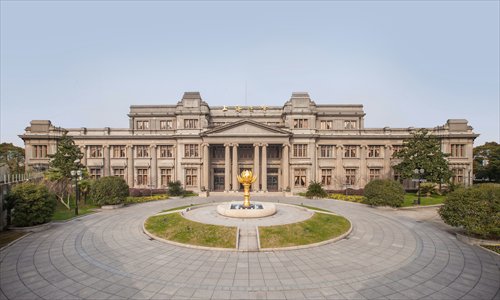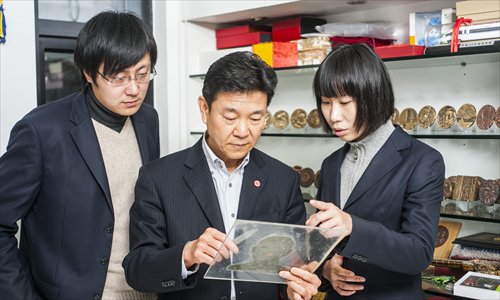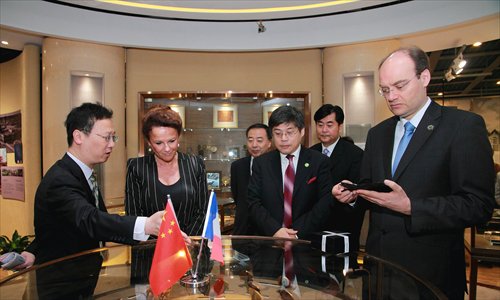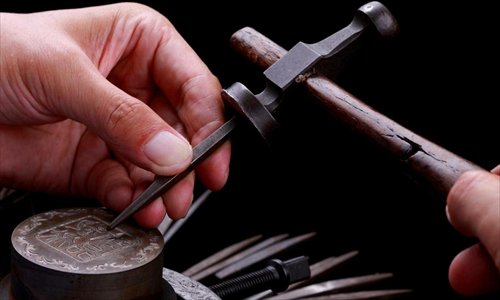The Shanghai Mint Company blends skill and art

The Shanghai Mint in Putuo district Photo: Courtesy of the Shanghai Mint
Behind the loose change that accumulates in pockets, wallets and purses every day, lies an amazing story of tradition, skill and art. Some examples of this can be found at the Shanghai Mint Museum, which is located in an imposing building on Guangfu Road West in Putuo district.
It's also the home of the Shanghai Mint, which produces the coins everyone in the country uses. Built in 1920, this building has witnessed the development of the past 94 years of China's coin production.
At present some 600 bronze medals are on display there in the Sino-French Bronze Medal Art Exhibition which opened at the museum on May 17, to celebrate the 50th anniversary of the establishment of diplomatic relationships between China and France.
The Shanghai Mint was not the first to make coins in China but was the first government-established coin manufacturer. Since 1955, after the establishment of the People's Republic of China, the company has been involved in the design or production of the coins in circulation - the 1, 2 and 5 fen, 1, 2 and 5 jiao and 1 yuan coins.
The most widely circulated 1 yuan coins in China at present with their peony and chrysanthemum designs were created by artists and engravers at the company.
Although Shanghai people use these coins every day, it remains for most a mystery as to how the coins have been created.

Luo Yonghui (center), deputy general artist at the Shanghai Mint, looks over a pattern with a young designer. Photo: Courtesy of the Shanghai Mint
A long history
China has a long history of coin manufacturing going back to ancient China when gold and silver coins were made and used. Modern coin manufacturing began at the end of the Qing Dynasty (1644-1911) when coin press machinery was introduced to China from the West.
The Shanghai Mint produced fen coins between 1955 and 1980. In the 1980s 1 yuan and jiao coins appeared and in 1991 the peony design 1 yuan coin appeared with the chrysanthemum design being released in 2001.
Before the 1 yuan peony coin was produced, coins were made of aluminum and copper alloys. The 1 yuan peony coin adopted a new production method involving nickel-plated steel, which reduced the cost of production of the coins and increased their life span - nickel is a hard metal that is corrosion resistant.
Although the new ingredients cut the cost of production they also brought new problems in manufacturing.
The production process of a coin has three main stages: the first stage sees the design created, the second turns the flat design into a relief pattern on a die and the third stage sees the die used to strike a blank piece of metal to create the actual coin.
Because nickel is harder than aluminum, it puts restrictions on the depth of the relief on the surface of a coin. To design and engrave a coin requires exceptional skills and experience.
Fang Maosen is former deputy general artist and senior craftsman with the Shanghai Mint. He explained: "The depth of the relief on aluminum and copper alloy coins can be up to 30 strands (the diameter of a human hair is seven strands on average) but the nickel plating is just 25 strands deep. So the depth of relief on a nickel-plated coin can be only eight strands at the most, just slightly thicker than a human hair. The shallowest part of the design is only four or five strands deep. So there were huge challenges for the engravers. They had to produce a design that was actually quite shallow but would seem to be three dimensional. Modern computer technology has made aspects of this work easier."
When the central bank decided to issue a new 1 yuan coin in 1991, experts from across the nation suggested design themes that included plants, animals, family planning and national achievements.
"Because most people enjoy flowers, the flower theme was adopted for the coins with different patterns including peonies, plum flowers and chrysanthemums representing Chinese characteristics," said Fang. "Creating flower designs for coins is also very difficult and the artists have to decide whether to choose one example or several."
After the design was selected came the most difficult part of the process - the actual engraving.

Marie-France Marchand Baylet, the wife of the French Foreign Minister, looks closely at exhibits in the Sino-French Bronze Medal Art Exhibition. Photo: Courtesy of the Shanghai Mint
Different form
"Engraving is a different art form from designing. Different engravers can produce coins that seem totally different even though they work from the same original design," said senior craftsman Yu Min, whose engraving of a peony was adopted for the 1991 1 yuan coin.
"Different people have a different understanding of the designs and with different techniques, their works are quite different," said Zhang Chunye, whose chrysanthemum engraving was adopted for the 2001 1 yuan coin.
The engravers initially carve an enlarged design in clay which then becomes a plaster die. The engraver then works on the plaster die before it is set in bronze and coated with nickel. Then the oversized coin die is reduced and becomes a steel die which fits onto the coin machine where it will stamp the blanks into coins. With the advancement of technology, some of the procedures can be accomplished by computer.
As the youngest engraver in the company, it was a surprise to Yu, who is now in his late 50s, that his peony engraving was chosen for the 1 yuan coin which was produced in the mid- 1980s. Four casts of the peony design were created by different engravers but Yu's engraving was chosen because of its detail and his dedication.
"The assessors of the coin designs and engravings included botanists, whose appreciation of the actual veins in the leaf of a peony finally determined that my pattern was chosen. We made the plaster die of the design based on photographs of peonies. But the experts pointed out that leaf veins should be indented not raised. So mine was chosen and another artist's peony engraving missed out even though his looked brilliant," Yu said.
Yu's hard work and the way he constantly pursued perfection contributed to his success. To make his peony appear natural he made new versions of the plaster engraving over and over again.
As well as producing real money, the company designs and produces commemorative coins like common commemorative coins, bullion commemorative coins and commemorative medals.

A hand engraver at work with some of his tools Photo: Courtesy of the Shanghai Mint
Quick progress
More than 12 designers and engravers work here. "Some of the younger engravers with an understanding of art progress quickly," said Yu.
The company today offers young employees a range of advanced study opportunities. Young Shanghai Mint designers like Zhu Xihua and Chen Yanwen have proven their worth by claiming major awards for their work.
And in recent years there has been fierce competition between engravers here and those working for other mint companies in Nanjing, Shenyang and Shenzhen.
"The quality of the design and engraving of commemorative coins is much higher nowdays. In the past, these tasks were designated to one artist, but now we have to compete for work," said Zeng Chenghu, a designer and craftsman with the company. "The competition also pushes the engravers to higher levels. Even though this is difficult work success is a great reward."
Almost impossible
Compared with the skills needed for machine-struck coins, the demands on the people who hand engrave coins are almost impossible. For this engravers work directly onto a die which is the same size as the coin.
The hand engraving skills of the Shanghai Mint were listed as an intangible cultural heritage in 2007.
Hand engraving was introduced to China about 100 years ago and the Shanghai Mint now has seven hand engravers. Fang Maosen and Huang Jian are the two senior engravers, who now work on commemorative bronze medals. "Hand engraving is completely different to machine engraving. The skills cannot cross over," said Zeng.
"Hand engraving is difficult to learn. You have to have great patience and most people who start to learn this give it up. Producing a commemorative medal can take many months of work," Zeng said.
Newspaper headline: More than small change